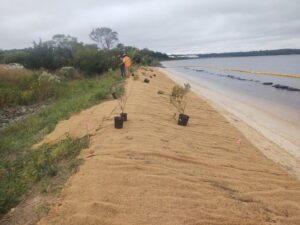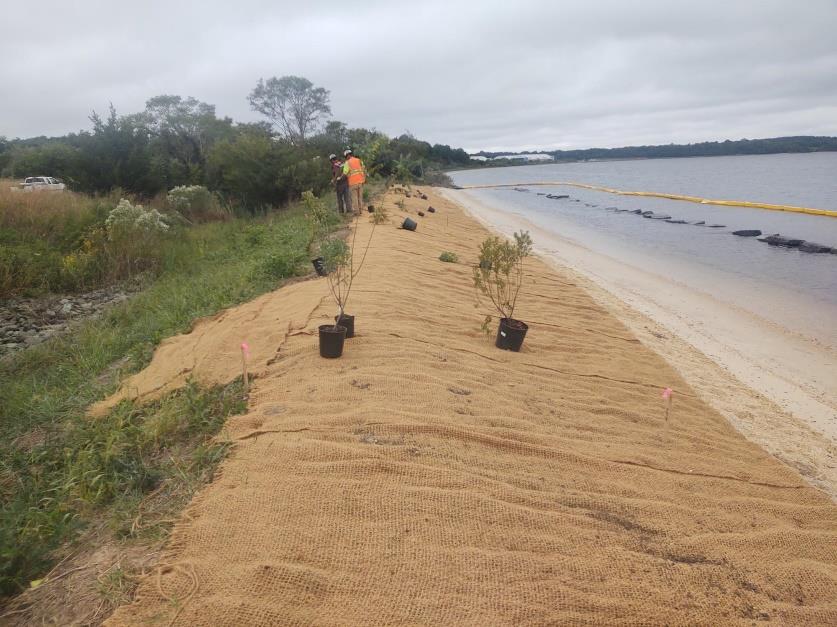 4/6/2023 – This Earth Day was an extra-special one for Naval Air Station (NAS) Patuxent River. The Navy base’s Environment Division will be honored by St. Mary’s County with a Sustainability Award for a shoreline restoration project to stop soil erosion and rebuild natural habitat areas on the Patuxent River.
4/6/2023 – This Earth Day was an extra-special one for Naval Air Station (NAS) Patuxent River. The Navy base’s Environment Division will be honored by St. Mary’s County with a Sustainability Award for a shoreline restoration project to stop soil erosion and rebuild natural habitat areas on the Patuxent River.
The Commissioners of St. Mary’s County and the St. Mary’s County Commission on the Environment have been jointly issuing the Sustainability Awards annually since 2020. They recognize local individuals or organizations for “environmental stewardship, resource conservation, innovative best practices, and pollution prevention efforts,” according to a county government news release.
The NAS Patuxent River Environment Division is one of two winners this year—the Southern Maryland Sierra Club is the other. This is the first time the award has gone out to a military installation, said Molly Boron, a commission member, adding that protecting the marine ecosystem benefits civilians and military personnel alike.
“A lot of our economic development and economy is based on sea life, on seafood, boating and recreation on the water,” she said. “When you have healthy ecosystems, it’s great for the entire community.”
The Navy base’s Environment Division will accept the award in a ceremony on April 22—Earth Day—at Summerseat Farm in Mechanicsville, Md. The public is invited.
The NAS Patuxent River project took place from 2021 to 2022 and created a 192-mile “living shoreline” of live beds of newly planted seagrass and other plants, combined with sand and a long wall of large stones. Conservationists define a “living shoreline” as one made with native plant life and natural landscapes—not just concrete and bulkheads.
Ben Hance, chair of the Southern Maryland Sierra Club, said that living shorelines not only safeguard against soil erosion but also support local wildlife and will be important in coming years for managing sea-level rise brought on by climate change.
“A living shoreline isn’t just putting a band-aid on the erosion problem. It’s adding to the ecosystem and providing the fuel for ecosystem regrowth and restoration,” said Hance. “Living shorelines are a major pillar of climate resiliency.”
Lance McDaniel, NAS Patuxent River’s environmental director, said that the plant beds in NAS Patuxent River’s living shoreline filters incoming water and helps trap more sand behind the rocks. Over time, accumulating sand will build back lost land areas. The plants also provide food and shelter to local wildlife, like the Diamondback Terrapin, which has numerous nesting sites in the area, said McDaniel and are at risk from sea-level rise.
“We’re strategically placing the stones, sand, and grass to create a revetment wall and make it into a living shoreline that increases the shoreline, gives us some sand back, and also creates some sanctuaries for smaller marine life,” he said.
NAS Patuxent River, situated near the meeting point of the Patuxent River and the Chesapeake Bay, has airfields and hangars where the Navy performs aircraft testing and training. These aircraft facilities are increasingly under threat from rising sea levels, which in recent years have been chipping away at the shoreline and at the manmade concrete bulwarks that safeguard the air facilities from flooding.
“The daily changing of the tide, it’s like a saw on the land. It cuts away at everything,” said McDaniel. He said that eventually, the water could break down the barrier completely and submerge whole air hangars and airfields.
The Department of Defense provided funding under its Readiness and Environment Protection Integration (REPI) program, which supports land and ecosystem conservation on and around military bases. Pax River received $3.4 million from REPI for living shoreline construction and coastline stabilization last year.
“I think there’s now more of an emphasis (in Navy planning) on identifying regional and installation-level climate impacts. It’s the Navy’s role to try to mitigate them and to sustain growth and mission readiness,” said Nathan Bomysoad, a REPI support specialist. “Implementing these projects in the near term preserves the mission in the long term.”
Bomysoad said that climate data indicates that the Chesapeake Bay region, including the Patuxent River shoreline, will experience a sea-level rise of 1.4 feet by 2050, progressing to 2-6 feet by 2100. And land erosion is occurring at a rate of 7-11 feet of shoreline loss per year in many areas.
Sea-level rise and soil erosion have become issues of growing concern at many Navy installations. The Department of the Navy now issues Climate Installation Physical Resilience awards, which fund Navy installation projects that address climate change and extreme weather events.
NAS Patuxent River will receive $2.1 million under this program in the coming year for four more shoreline projects. McDaniel said that protecting and restoring the shoreline will remain a high priority for NAS Patuxent River.
“We don’t want to lose any more of the land than we already have, so we have projects for every inch of shoreline down here,” McDaniel said. “Any time there’s money available from the Navy, we try to go out and get it so that we can take on some more of the erosion.”



